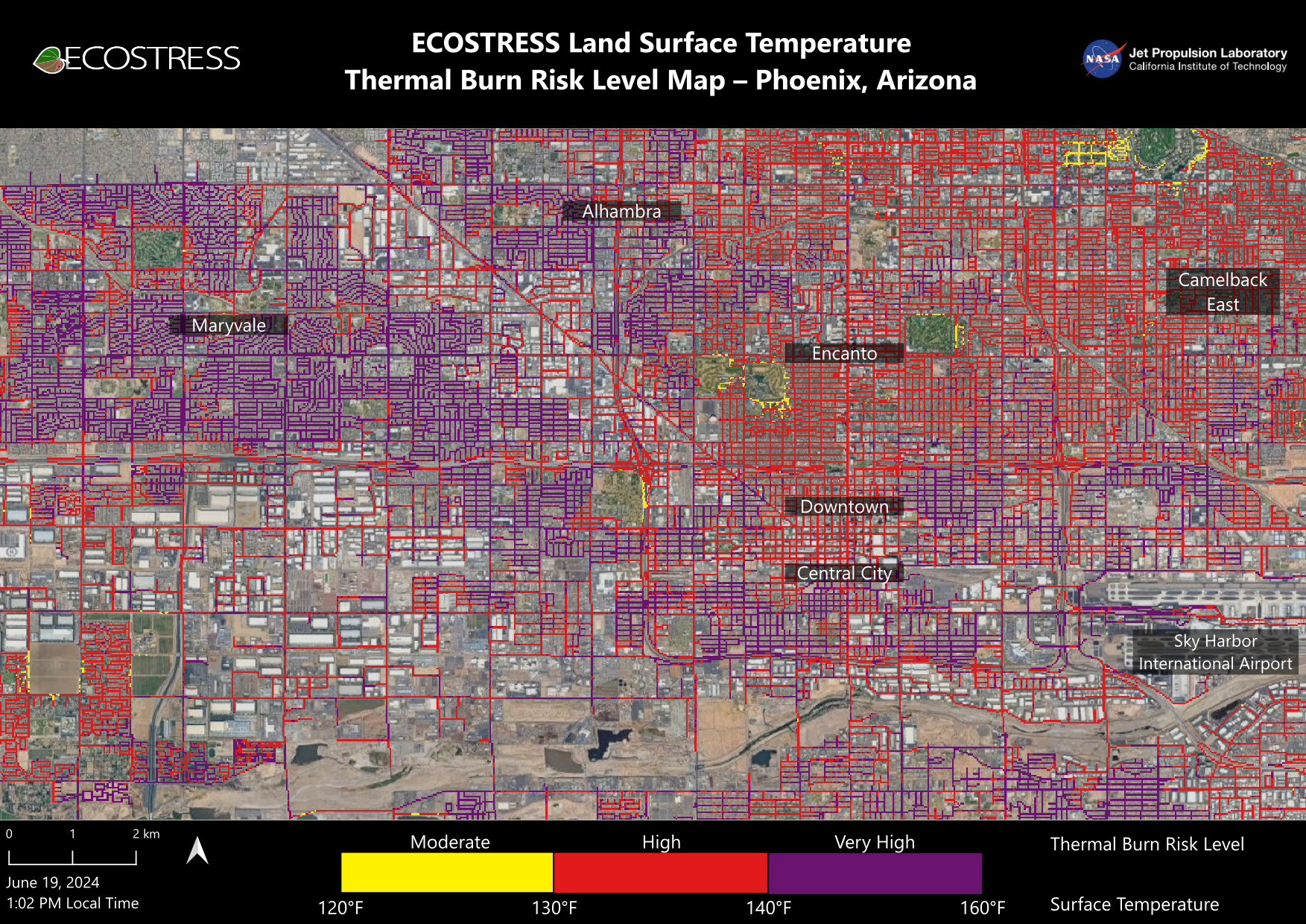NASA’s ECOSTRESS Maps Burn Risk Across Phoenix Streets

3 min readPreparations for Next Moonwalk Simulations Underway (and Underwater)
NASA’s ECOSTRESS instrument on June 19 recorded scorching roads and sidewalks across Phoenix where contact with skin could cause serious burns in minutes to seconds, as indicated in the legend above. NASA/JPL-Caltech
Roads and sidewalks in some areas get so hot that skin contact could result in second-degree burns.
Researchers at NASA’s Jet Propulsion Laboratory in Southern California have mapped scorching pavement in Phoenix where contact with skin — from a fall, for example — can cause serious burns. The image shows land surface temperatures across a grid of roads and adjacent sidewalks, revealing how urban spaces can turn hazardous during hot weather.
Data for this visualization of the Phoenix area — the fifth most populous city in the United States — was collected at 1:02 p.m. local time on June 19, 2024, by a NASA instrument aboard the International Space Station. Called ECOSTRESS (short for the Ecosystem Spaceborne Thermal Radiometer Experiment on Space Station), the instrument measures thermal infrared emissions from Earth’s surface.
The image shows how miles of asphalt and concrete surfaces (colored here in yellow, red, and purple, based on temperature) trap heat. The surfaces registered at least 120 degrees Fahrenheit (49 degrees Celsius) to the touch — hot enough to cause contact burns in minutes to seconds.
The image also shows cooling effects of green spaces in communities like Encanto and Camelback East, in contrast to the hotter surface temperatures seen in Maryvale and Central City, where there are fewer parks and trees.
“We create these maps to be intuitive to users and help make data more accessible to the public and citizens scientists,” said Glynn Hulley, a JPL climate researcher. “We see them as a vital tool for planning effective heat interventions, such as tree planting, that can cool down the hottest roads and sidewalks.”
Homing in on Heat
At the lower right of the image is Phoenix’s Sky Harbor International Airport, where ECOSTRESS recorded some of the hottest land surface temperatures within the city —around 140 F (60 C). The air temperature on June 19 at the airport reached 106 F (43 C).
Air temperature, which is measured out of direct sunlight, can differ significantly from the temperature at the land surface. Streets are often the hottest surfaces of the built environment due to dark asphalt paving that absorbs more sunlight than lighter-colored surfaces; asphalt absorbs up to 95% of solar radiation. These types of surfaces can easily be 40 to 60 degrees F (22 to 33 degrees C) hotter than the air temperature on a very hot day.
Launched to the International Space Station in 2018, ECOSTRESS has as its primary mission the identification of plants’ thresholds for water use and water stress, giving insight into their ability to adapt to a warming climate. But the instrument is also useful for documenting other heat-related phenomena, like patterns of heat absorption and retention.
To produce the image of Phoenix, scientists used a machine learning algorithm that incorporates data from additional satellites: NASA/USGS Landsat and Sentinel-2. The combined measurements were used to “sharpen” the surface temperatures to a resolution of 100 feet (30 meters) by 100 feet (30 meters).
More About the Mission
JPL built and manages the ECOSTRESS mission for the Earth Science Division in the Science Mission Directorate at NASA Headquarters in Washington. ECOSTRESS is an Earth Venture Instrument mission; the program is managed by NASA’s Earth System Science Pathfinder program at NASA’s Langley Research Center in Hampton, Virginia.
More information about ECOSTRESS is available here: https://ecostress.jpl.nasa.gov/.
News Media Contacts
Jane J. Lee / Andrew WangJet Propulsion Laboratory, Pasadena, Calif.818-354-0307 / [email protected] / [email protected]
Written by Sally Younger
2024-096
Share
Details
Last Updated
Jul 02, 2024
Related TermsEcostress (ECOsystem Spaceborne Thermal Radiometer Experiment on Space Station)Earth ScienceExtreme Weather EventsJet Propulsion LaboratoryWeather and Atmospheric Dynamics
Explore More
4 min read
NASA’s Planetary Radar Tracks Two Large Asteroid Close Approaches
Article
22 hours ago
5 min read
NASA’s NEOWISE Infrared Heritage Will Live On
Article
3 days ago
2 min read
NASA@ My Library and Partners Engage Millions in Eclipse Training and Preparation
The Space Science Institute, with funding from the NASA Science Mission Directorate and Gordon and…
Article
6 days ago
Keep Exploring
Discover Related Topics
Missions
Humans in Space
Climate Change
Solar System
Welcome to Billionaire Club Co LLC, your gateway to a brand-new social media experience! Sign up today and dive into over 10,000 fresh daily articles and videos curated just for your enjoyment. Enjoy the ad free experience, unlimited content interactions, and get that coveted blue check verification—all for just $1 a month!
Account Frozen
Your account is frozen. You can still view content but cannot interact with it.
Please go to your settings to update your account status.
Open Profile Settings